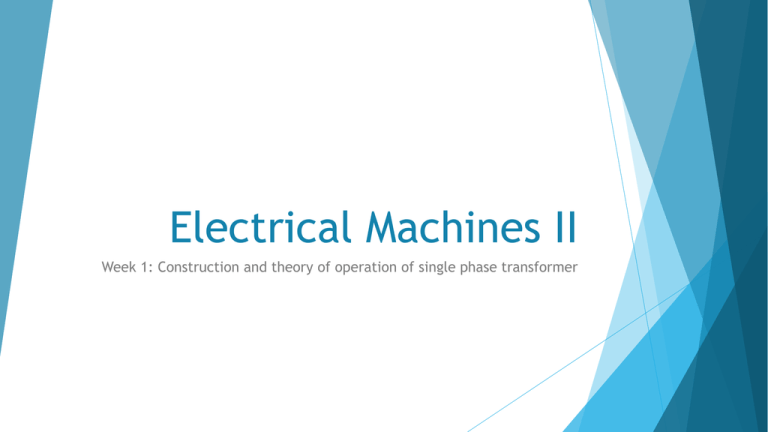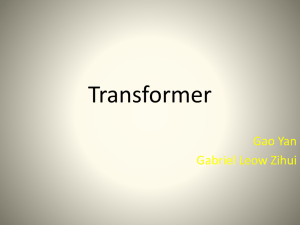Electrical Machines II
advertisement

Electrical Machines II Week 1: Construction and theory of operation of single phase transformer Transformers Overview A transformer changes ac electric power at one frequency and voltage level to ac electric power at the same frequency and another voltage level through the action of a magnetic field. Consists of two or more coils or wire wrapped around a common ferromagnetic core. The ONLY connection between these coils is the common magnetic flux present within the core. Coils, Inductances, low power Transformers Unit transformer: transmission Power Transformers Pole mounted single phase distribution transformer Uses and applications of transformers Transformers are used in many applications: Step up/ step down voltage/current Instrumentation (PT and CT) Isolation Phase shifting CTs Substation power transformer Phase shifting transformer for power flow control SF6 110 kV current transformer TGFM series, Russia instrument isolation transformer showing two polarity marking conventions Power Transformer Constructed on one of two types of cores. Core types transformer: Simple rectangular laminated piece of steel with the transformer windings wrapped around two sides of the rectangle. Shell type transformer: three legged laminated core with the windings wrapped around the center leg. Both types of transformers are made of thin laminations electrically isolated from each other in order to reduce the eddy current losses Physically, the primary and secondary windings are wrapped one on top of the other with the low voltage winding innermost. Reduces the leakage flux+ simplifies insulation problem for the high voltage winding Primary and Secondary Windings – A two-winding transformer consists of two windings interlinked by a mutual magnetic field. – Primary winding – energized by connecting it to an input source. We’ll define the “primary” side of the transformer as the side that usually receives power from a line and – Secondary winding – winding to which an electrical load is connected and from which output energy is drawn. Theory of operation: Np: Number of turns on the primary winding Ns: Number of turns on the secondary winding vp(t): voltage applied to the primary side vs(t): voltage at the secondary side a: turns ratio ip(t): current flowing into the primary side is(t): current flowing into the secondary side Theory of operation: • A transformer basically consists of two coils wound around a common soft iron core. • When an alternating voltage ( VP ) is applied to the primary coil, current flows through the coil which in turn sets up a magnetic field around itself, called mutual inductance, by this current flow according to Faraday’s Law of electromagnetic induction. The strength of the magnetic field builds up as the current flow rises from zero to its maximum value which is given as 𝒅𝝋 𝒅𝒕. • As the magnetic lines of force setup by this electromagnet expand outward from the coil the soft iron core forms a path for the magnetic flux. This Assume ideal transformer – no real power losses (no resistance losses) – magnetic core has infinite permeability – no leakage flux magnetic flux links the turns of both windings (primary and secondary) as it increases and decreases in opposite directions under the influence of the AC supply. • However, the strength of the magnetic field induced into the soft iron core depends upon the amount of current and the number of turns in the winding. When current is reduced, the magnetic field strength reduces. Theory of operation: • When the magnetic lines of flux flow around the core, they pass through the turns of the secondary winding, causing a voltage to be induced into the secondary coil. The amount of voltage induced will be determined by: 𝑵 𝒅𝝋 𝒅𝒕 (Faraday’s Law). Also this induced voltage has the same frequency as the primary winding voltage. • Then we can see that the same voltage is induced in each coil turn of both windings because the same magnetic flux links the turns of both the windings together. As a result, the total induced voltage in each winding is directly proportional to the number of turns in that winding Ideal Transformer First we review the voltage/current relationships for an ideal transformer – no real power losses – magnetic core has infinite permeability – no leakage flux – primary is usually the side with the higher voltage, but may be the low voltage side on a generator step-up transformer. 9



